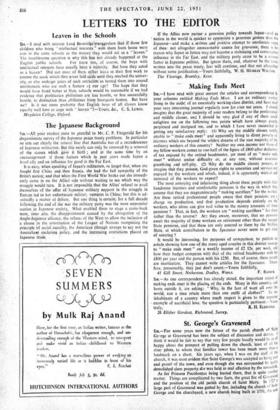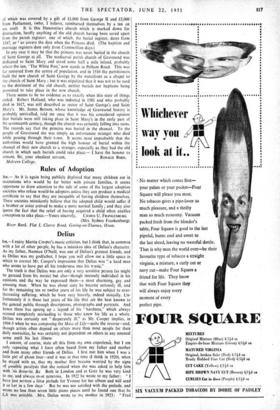St. George's Gravesend Sin, —For some years now the future
of the parish church of Saint George at Gravesend has been the subject of discussion and debate 1 think it would be fair to say that very few people locally would be at all happy about the prospect of pulling down the church, least of all the i river pilots, to whom that familiar tower has been much more than I landmark on a chart. Six years ago, when I was on the staff of the church, it was most evident that Saint George's was accepted as being pad and parcel of the town, and even though she was surrounded by rah' demolished slum property, site was held in real affection by the townsfolk. As for Princess Pocohontas being buried there, that is quite another matter. Things are complicated by two facts, the great fire of Gravesend -; and the position of the old parish church of Saint Mary. In 17271 large part of Gravesend was gutted by fire, including the church of S3i°11 George and the churchyard, a new church being built in 1731, the 011 of which was covered by a gift of £1,000 from George II and f5,000 from Parliament, (who, I believe, reimbursed themselves by a tax on sea coal) It is this Hanoveriai church which is marked down for destruction, hardly anything of the old church having been saved apart from the parish registers; one of which, the burial register, dates from 1547, ar I so covers the date when the Princess died. (The baptism and marriage registers date only from Cromwellian days.)
In any case it may be that the princess was never buried in the church of Saint George at all. The mediaeval parish church of Gravesend was dedicated to Saint Mary and stood some half a mile inland, probably where the inn, 'The White Post,' now stands in Pelham Road. This was far remqved from the centre of population, and in 1510 the parishioners built the new church of Saint George by the waterfront as a chapel to the chUrch of Saint Mary ; but it was stipulated that it was not to be used to the detriment of the old church, neither burials nor baptisms being permitted to take place in the new church.
There seems to be no evidence as to exactly when this state of things ended. Robert Holland, who was inducted in 1581 and who probably died in 1617, was still described as rector of Saint George's and Saint Mary's. Mr. James Benson, whose knowledge of Gravesend history is probably unrivalled, told me once that it was his considered opinion that burials were still taking place in Saint Mary's in the early part of the seventeenth century, though the church was certainly falling into ruins. The records say that the princess was buried in the chancel. To the people of Gravesend she was simply an unfortunate stranger who died while passing through their town. It seems most improbable that the authorities would have granted the high honour of burial within the chancel of their new church to a stranger, especially as they had the old church in which such burials could take place.— I have the honour to remain, Sir, your obedient servant, RONALD HORN. Malvern College.



















































 Previous page
Previous page